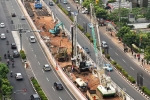This article has been translated by PwC Indonesia as part of our Indonesia Infrastructure News Service. PwC Indonesia has not checked the accuracy of, and accepts no responsibility for the content.
Bisnis Indonesia - Infrastruktur pelabuhan: Jawa Tengah giat berbenah
16 June 2025
By Muhammad Faisal Nur Ikhsan
Central Java possesses vast maritime potential that remains largely untapped. To address this, several regions are planning to revitalise port infrastructure to stimulate industrial and trade ecosystems.
The province, whose emblem bears the Kundi Amarta over waves, has a coastline stretching 971.52 kilometres across 17 regencies along its northern and southern coasts. This potential remains underutilised, yet it offers promising prospects for investment and development.
In the fisheries sector, Central Java boasts a variety of high-value wild-caught fish commodities, such as scad, mackerel, yellowtail scad, Indian sardine, lemuru, and croaker. It also has significant aquaculture potential, including milkfish, grouper, and seaweed.
From a logistics supply chain perspective, Central Java's central location on Java Island—flanked by the Java Sea to the north and the Indian Ocean to the south—adds to its strategic value.
Furthermore, the presence of 33 small islands along its coast opens opportunities for marine tourism and blue economy development.
To harness this potential, the Central Java Provincial Government and several local governments plan to revitalise their commercial and fisheries ports.
Governor Ahmad Luthfi has confirmed that revitalising Tanjung Emas Port is a priority, supporting export-import activities and logistics efficiency for industrial zones that have grown rapidly in recent years.
“This revitalisation must be completed within a year because export-import value is projected to increase in line with ongoing investment in national strategic projects (PSNs) and other developments,” Luthfi said on Friday (25 May).
The revitalisation effort also aims to address risks facing Tanjung Emas Port, particularly land subsidence of 13–17 cm per year, which requires a tiered wharf design.
Plans include rearranging dock structures, upgrading logistics facilities, and deepening distribution channels as part of the port’s wider development.
Luthfi hopes the revitalisation will meet the needs of businesses in Central Java. Ideally, Pelindo’s investment will effectively serve rising logistics demands, particularly for export-import activities expected to surge over the next one to two years.
According to Statistics Indonesia (BPS) data, cargo volume at Tanjung Emas Port rose consistently from 2020 to 2024. In 2020, unloading and loading volumes were 6.1 million tonnes and 196,615 tonnes, respectively. By 2024, these had jumped to 315 million tonnes unloaded and 126 million tonnes loaded.
Harry Nuryanto Soediro, Chair of the Central Java Chamber of Commerce and Industry (Kadin), welcomed the plan to revitalise Tanjung Emas Port. He said the business community has long awaited this move, driven by rising production and trade capacity from the province.
Potential in regencies
However, revitalisation is needed not only at Tanjung Emas Port in Semarang. Central Java Kadin is also encouraging local governments to explore upgrading other ports across the region.
“If regencies or cities have the potential to initiate similar port revitalisation projects, we fully support it,” he said.
He added that some port functions at Tanjung Emas should be relocated—for instance, inter-island shipments could be moved elsewhere—so that international activities can be centralised there, easing the burden on the port.
Beyond Tanjung Emas Port, Central Java has many ports along its mid-coastal corridor. In fact, it holds the highest number of fisheries ports in the country, totalling 61 facilities.
These consist of one national fisheries port, nine coastal fisheries ports, three fish landing bases, and 47 non-classified fisheries ports. The Ministry of Marine Affairs and Fisheries has also identified 17 potential port locations.
In Pemalang Regency, revitalisation of the Asemdoyong Fisheries Port is underway, with a project budget of around Rp30 billion. Of this, Rp4.65 billion is allocated for building a 220-metre breakwater.
Additional works include dredging the Elon River estuary and port basin, with funding of Rp2.9 billion. “The project is targeted to be completed in 150 days. The first funding phase is Rp7.55 billion, with later phases bringing the total to around Rp30 billion,” said Ahmad Luthfi.
Asemdoyong’s location is seen as strategic. In 2024, the fisheries port handled 1,115.75 tonnes of landed catch, worth Rp111.9 billion—half of Pemalang’s total captured fisheries production.
Elsewhere, port revitalisation plans have also emerged in Pekalongan City. M. Azmi Basyir, Chair of the Pekalongan Regional Legislative Council (DPRD), stated that an onshore port development project would deliver strategic benefits for economic and logistics growth, particularly in infrastructure, supply chains, and employment.
“We will support this planning process with the local government through this year’s budget discussions to ensure clarity on both the project and related policy decisions,” Azmi explained.
However, the onshore port plan in Krapyak Lor, Pekalongan City, faces challenges, such as land acquisition and road access upgrades to integrate the project with other supporting infrastructure.
Therefore, Azmi said the local government must strengthen communication and coordination with the central government to secure sustained funding and project execution.
“This is not just a major infrastructure project—it is also an opportunity for local communities to benefit directly in terms of economic opportunities and wellbeing. If budget shortfalls occur, we will work with the local and central governments to find solutions,” he added.
The economic potential of port facilities has also gained attention in Jepara Regency. Over the past few years, there has been interest in establishing an international port in the region.
That interest has been renewed following a visit by the Spanish Ambassador, who inspected a 900-hectare plot in Balong Village, Kembang District, that has been earmarked for a future international port project.
The revitalisation of various ports across Central Java is expected to revive the industrial and trade ecosystems within the region.
Contact us















